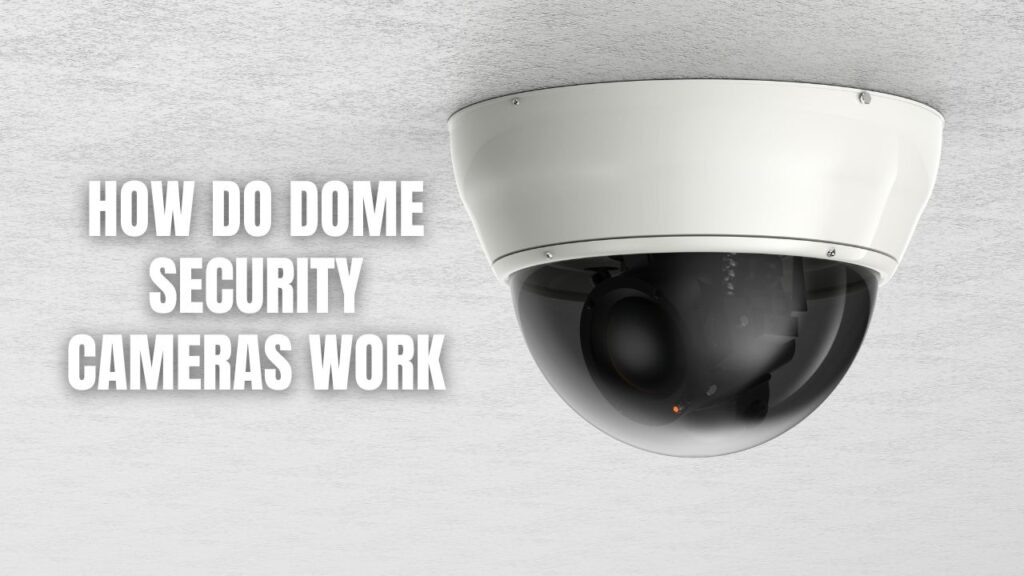Dome security cameras have become an increasingly popular choice for home and business video surveillance systems. Their discreet, compact design hides the internal components while still providing high-quality video monitoring. In this post, we’ll take a closer look at what’s inside these cameras and how they operate.
An Overview of Dome Camera Components
A dome security camera gets its name from the dome-shaped plastic or metal casing that houses the internal camera components. Under this dome, you’ll find the core elements:
- Camera lens – The camera lens gathers light and focuses it onto the image sensor, just like the lens in a digital camera. Dome cameras often use wide-angle lenses to provide a broad field of view.
- Image sensor – The image sensor is a digital chip that captures the focused light and converts it into digital video images. Popular image sensors in security cameras include CCD and CMOS sensors.
- Processor – The processor analyzes the video data from the image sensor and compresses it into video footage. The processor enables features like motion detection and sends the video signal to other components.
- Power supply – A built-in transformer steps down A/C power to lower voltage D/C power to operate the camera. Many dome cameras can also operate on Power over Ethernet (PoE).
- IR LEDs – Infrared LEDs provide illumination for low light and night vision. The LEDs surround the lens inside the dome casing.
- Housing – The dome casing not only protects the internal components, but its tinted material also helps conceal the camera’s orientation.
How Dome Cameras Capture and Transmit Video
Now that we’ve looked at what’s inside a dome security camera, let’s see how these key components work together:
The process starts when the camera lens gathers light from the surrounding area. The lens focuses this light onto the image sensor, creating an optical image. The image sensor measures the light from the lens and converts it into an electrical signal through millions of light-sensitive pixels.
The processor then analyzes this electrical signal and processes it into a digital video format. Part of this processing includes compressing the video data so that it takes up less storage and network bandwidth when transmitted to security monitors.
At the same time, the processor performs video analytics like motion detection by comparing frames of video to detect changes. When motion triggers the camera, it can send an alert or mark the event footage.
Power from either the external source or PoE enables all the camera components to operate. The IR LEDs supplement the existing visible light to enable night vision capabilities.
The dome casing helps conceal the camera’s panning direction and houses the shatter-resistant dome bubble that protects the lens. While still allowing the camera to remain inconspicuous, the dome offers a distortion-free view of the surveillance area.
Finally, the video data transmits over coaxial cable or Ethernet depending on the security system. For example, the camera can connect to a digital video recorder to store and manage footage or stream directly to a central monitoring application.

Key Dome Camera Features and Technologies
Beyond core functionality, dome cameras also include features to expand their surveillance capabilities:
- Pan, tilt, zoom (PTZ) – Many dome cameras feature remote-controlled PTZ to pan left and right, tilt up and down, and zoom in on areas of interest. The PTZ controls integrate directly with the dome housing.
- Wide dynamic range (WDR) – WDR helps dome cameras compensate for uneven lighting conditions, capturing details in very bright and dark areas of a scene.
- Infrared (IR) illumination – IR LEDs inside the dome housing enable night vision at distances up to 100 feet or more. The camera automatically activates IR in low ambient light.
- Vandal-proof casing – Dome cameras have a rugged metal or plastic casing designed to withstand tampering, along with polycarbonate dome bubbles that resist impacts.
- Weather resistance – Outdoor dome cameras include weatherproofing like silicone gasket seals to operate in rainy, snowy, or high-humidity environments.
- Remote access – Using an app or web-based service, users can view live and recorded video feeds from dome cameras on smartphones and computers.
- Smart motion detection – Integrated video analytics automatically detect motion and trigger alerts while reducing false alarms from environmental changes like shadows and trees.
Where are Dome Cameras Commonly Deployed?
Thanks to their versatile design, dome cameras work well in many indoor and outdoor surveillance applications:
- Home security – Homeowners often choose dome cameras to monitor driveways, doorsteps, patios, and yards for property protection and deliveries.
- Business security – Retail stores use discreet ceiling-mounted dome cameras to unobtrusively monitor checkout areas. Warehouses and manufacturing facilities also rely on dome cameras.
- Public security – Dome cameras deployed in city centers, parks, and transit systems help law enforcement respond to incidents and manage crowds.
- Commercial fleets – Trucking and transportation companies integrate dome cameras with DVRs for driver monitoring and collision recordings.
- Healthcare security – Healthcare facilities install vandal-resistant dome cameras in emergency rooms, pharmacies, and other sensitive areas.
- Education security – Schools deploy indoor and outdoor dome cameras to monitor hallways, parking lots, and entryways for student safety.
Dome camera placement depends on the facility and surveillance goals. For broad coverage, dome cameras mount high on walls or ceilings. For more targeted areas like doorways, point-of-sale counters, or equipment, dome cameras install closer to the zone of interest.
What are the Pros and Cons of Dome Security Cameras?
Dome security cameras offer many advantages but also come with some limitations to consider:
Pros:
- Compact, discreet design
- Easy ceiling or wall mounting
- Vandal-proof durability
- No exposed PTZ mechanics
- Wide field of view
- Simple wiring through housing
- Flexible wireless options
- Clear optical dome cover
Cons:
- Difficult for remote lens adjustments
- PTZ and zoom capabilities less effective from afar
- Small form factor limits component sizes
- Dome bubble prone to scratches over time
- Visible IR night vision effect
- Limited wired range without PoE switch
When choosing security cameras for your property, analyze the monitoring goals, installation environment, and features to determine if a dome camera matches your needs. They excel in providing versatile, low-profile surveillance. However, for large open areas or highly precise zoom focus, larger PTZ cameras may be preferable.
Final Thoughts
Dome security cameras continue to be a top choice for discrete video surveillance with their compact profile and easy mounting. By packaging the key components into a durable dome enclosure, these cameras provide reliable monitoring for indoor and outdoor spaces. Features like remote pan/tilt/zoom controls, infrared night vision, and vandal resistance further expand the capabilities.
Understanding how dome cameras work gives you insight into their strengths and limitations. When deployed properly, dome cameras give homeowners and businesses a powerful security asset without dominating or detracting from the area. Just be sure to test camera positioning and lighting conditions to optimize the video quality and coverage. With their unique durability and performance, dome cameras will continue to be a fixture in security systems moving forward.
If you’re looking for dome cameras and installation around Central and North Georgia, consider contacting Callaway Security™!












